(HOT) UPSC Current Affairs 2025 PDF
NEW! The Gist (NOV-2025) | E-BOOKS
(Download) UPSC IES Exam Paper - 2018 "Electrical Engineering Paper - 1"
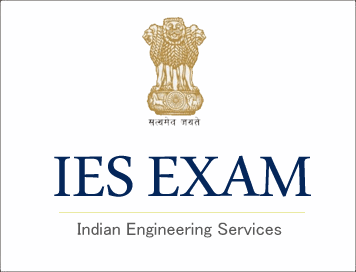
(Download) UPSC IES Exam Paper - 2018 "Electrical Engineering Paper - I"
Exam Name: Engineering Services Exam (IES)
Paper : ELECTRICAL ENGINEERING Paper - I
Year: 2018
File Type: PDF
ELECTRICAL ENGINEERING
Paper - I
Time Allowed : Three Hours
Maximum Marks : 300
QUESTION PAPER SPECIFIC INSTRUCTIONS
Please read each of the following instructions carefully before attempting questions.
There are EIGHT questions divided in TWO Sections.
Candidate has to attempt FIVE questions in all.
Question Nos. 1 and 5 are compulsory and out of the remaining, THREE are to be attempted choosing at least ONE question from each Section.
The number of marks carried by a question / part is indicated against it.
Answers must be written in the medium authorized in the Admission Certificate which must be stated clearly on the cover of this Question-cum-Answer (QCA) Booklet in the space provided. No marks will be given for answers written in medium other than the authorized one.
Assume suitable data, if considered necessary and indicate the same clearly.
Unless otherwise mentioned, symbols and notations carry their usual standard meanings.
Attempts of questions shall be counted in sequential order. Unless struck off, attempt of a question shall be counted even if attempted partly. Any page or portion of the page left blank in the Question-cum-Answer Booklet must be clearly struck off.
SECTION ‘A’

1.(C) Silicon diode that has an ohmic resistance of 0.5 W with reverse saturation current I0= 10-12 A and n = 2.0, consumes 50x10-12 W extra power compared to ideal diode. Diode operating temperature is 350°K.
(i) Determine the fraction of the applied voltage that falls across the
ohmic resistance.
(ii) Solve part (i), when diode current is 1A.
(iii) Compare results of part (i) & (ii) and draw conclusion.
1.(D)
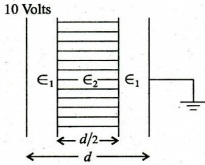
A parallel plate capacitor consisting of two dielectric materials is shown in figure. The middle dielectric slab is placed symmetrically with respect to the plates. If the potential difference between one of the plates and nearest surface of dielectric interface is 4 volts, determine E1/E2. Assume parallel plate capacitor has an electrode area of A m2
1.(E)
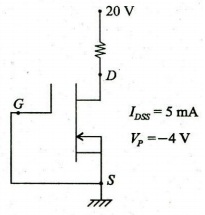
Write the equation related to the drain current (ID) and Gate to source voltage Vos explaining all the parameters for
(1) Depletion type MOSFET
(ii) Enhancement type MOSFET
(iii) Determine VDS for the circuit shown in the figure.
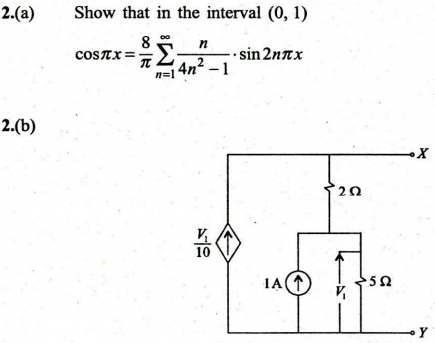
Determine the value of Load Resistance RL to be connected across terminals X-Y to receive maximum power. Also, obtain the value of this maximum power.
2.(C)
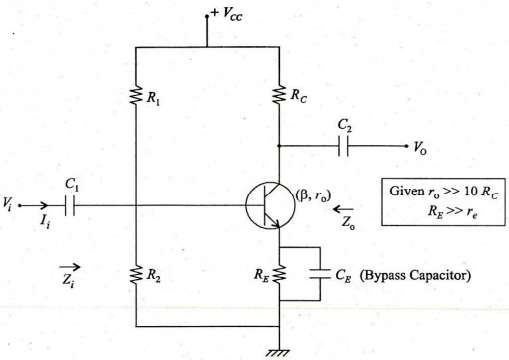
Obtain the expression for voltage gain to given circuit.
(i) With bypass capacitor.
(ii) Without bypass capacitor.
(iii) Calculate voltage gain in part (i) & part (ii), if R1 = 90 kW,
R2 = 10 W,
RE=0.8 kW, B = 200, r° = 50 kW,
Rc = 2.2 W, and VCC= +15 V.
Compare both voltage gains and write conclusion in short.
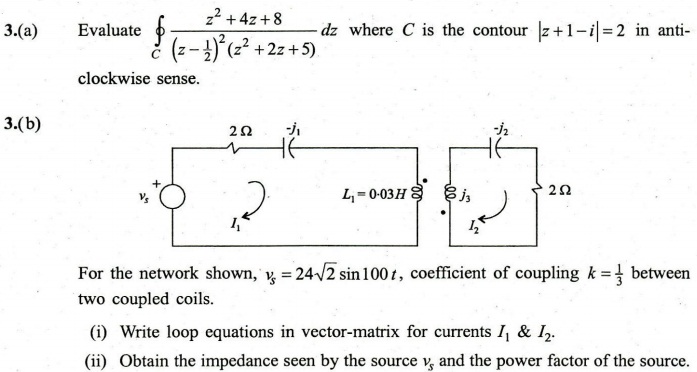
3.(C)
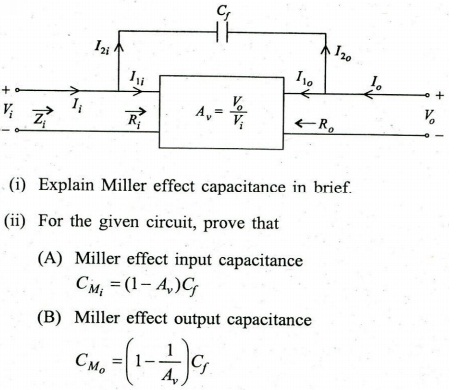
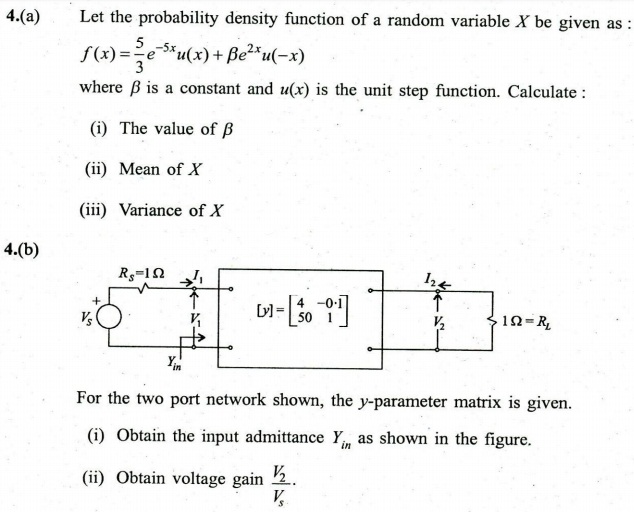
4.(C)
(i) State whether the given statement is true or false for practical
oscillators with reasons. “Loop 'gain is generally made slightly larger than
unity.”
(ii) In a general form of oscillator circuit given in figure.
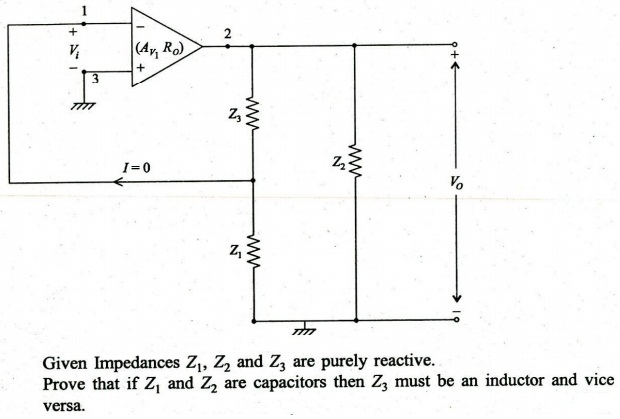
Study Material for IAS (UPSC) General Studies Pre. Cum Mains
SECTION 'B'
5.(A) Mention the type of Bravais space lattice, relationship of crystal axial lengths (x,y,z) and relationship of interaxial angles (a, b, g) in the following order of the crystal system.
(i) Triclinic
(ii) Monoclinic
(iii) Orthorhombic and
(iv) Trigonal
5.(B) A standard cell of 1.0185 V used with a simple potentiometer balances at 50 cm. Calculate
(i) the emf of cell which balances at 72 cm
(ii) the percentage error in voltmeter which balances at 64.5 cm when
reading1.33 V
(iii) Percentage error in an ammeter that reads 0.43 A and balance is obtained
at 43.2 cm with Pd across a 2W resistor in the
ammeter circuit.
5.(C) (i) Write down algorithm in Pseudocode for sorting an array in descending order. Specify the name of the algorithm you have used.
(ii) Write a program segment in any higher level language for Linear search problem. (Specify which language you are using.)
5.(D) A non-inductive shunt is used to increase the range of a 10 A moving iron ammeter to 100 A. The impedance of the instrument including the leads is (0.06 +j 4.71x10-3) W. If the combination is correct on a dc circuit, find the error on ac circuit.
5.(E) (i) Explain the electrochemical breakdown in insulators and discuss any two factors that accelerates the breakdown.
(ii) A magnetic material having almost a square hysteresis loop has a coercivity of 50 A/m and a remanence of 0.5 T. If this material is used in a toroidal inductor of mean diameter 1.6 cm, with a cross-sectional area of 0.25x10-4 m2, calculate the power loss at a frequency of 50 Hz when the material is driven around one complete hysteresis cycle.
6.(A) (i) Explain electrical resistivity of metals in terms of thermal and residual components. Also draw the schematic variation of them with respect to temperature.
(ii) Write the relation between magnetic susceptibility and temperature according to Curie Law, Curie-Weiss Law and Neel Law. Sketch the variation of reciprocal of susceptibility with temperature as per the above laws.
(iii) What are ferrites ? Mention 3 disadvantages. State the reason, why ferrites are suitable for high frequency operation.
6.(B) (i) Prove that the most probable value is the mean value.
(ii) What is an RS-232 interface ? How many signals it can handle ? How many wires are sufficient for operation ?
(iii) What is creeping in energy meters ? State the reasons for the same and how it is avoided.
6.(C) (i) Can we use Semiconductor Memory for secondary storage ? Justify your answer.
(ii) What exactly is the role of Control Unit in CPU ? How is it different from that of an Arithmetic Logic Unit?
(iii) How exactly is an array stored in main memory ? Illustrate with the help of of a matrix. What will be the exact address of element A(3,7) of an 8x9 array A assuming that location of the first element is d.
7.(A) (i) Supporting with suitable figures, define initial permeability and maximum permeability. Mention the approximate range of values for iron. Mention one importance each of initial and maximum permeabilities.
(ii) Specific gravity of a ceramic is 3.2 g/cm3. Calculate the percentage apparent porosity and percentage true porosity with the following data :
Ceramic when weighed dry = 360 g
Ceramic when weighed after soaking in water = 385 g
Ceramic weighed while suspended in water = 224 g
(iii) What is photo-conductivity ? Discuss the factors that are to be considered for the selection of photo-conduction material.
7.(B)
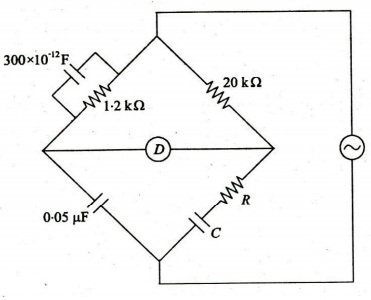
For the bridge circuit shown determine the values of R and C. Derive the formula used.
7(C) (i) How is Division exactly done by ALU ?
(ii) Prove with illustration that NAND is a “Universal Gate”.
(iii) How will you implement a two-way switch using minimum number of logic gates ?
8.(A) (i) Explain the Top-Bottom and Bottom-Up approach to produce the nanostructure. Name the methods used in each case to produce nanomaterial.
(ii) The current measured in a superconducting ring by 0.01% accuracy meter after one year shows no decay of current. If there are 1028 electrons/m3, calculate the conductivity. How many times larger is this conductivity than that of copper of resistivity 1.724x10-8Wm.
(iii) Addition of 0.25 atomic percent nickel and 0.4 atomic percent silver into copper at 298 K increases the resistivity by 0-012 uWcm and 0.016 uWm respectively. If the resistivity of copper is 0.015 uWm at 298 K, determine the conductivity of the resulting alloy.
8.(B) The power consumed by a single phase 11 kV load taking 100 A at 0.5 powerfactor lagging is measured on a dynamometer wattmeter used in conjunction with potential transformer (PT) and current transformer (CT). Determine the reading of the wattmeter considering the following data:
Nominal ratio of PT and CT are 100 : 1 and 20:1
Ratio error of PT and CT are +0.8% and -0.2%
Phase angle errors of PT and CT are +42 minutes and +90 minutes.
Phase angle of the pressure coil due to its inductance is 30 minutes.
8.(C) (i) Is the use of Virtual Memory advisable for Real Time Systems ? Justify briefly your answer.
(ii) Compare briefly and precisely the LINUX OS with Windows-NT OS.
(iii) For File Management how does a DBMS help?

